
All categories
Featured selections
Trade Assurance
Buyer Central
Help Center
Get the app
Become a supplier

(1263 products available)
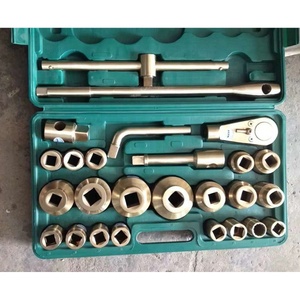
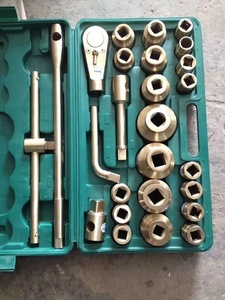











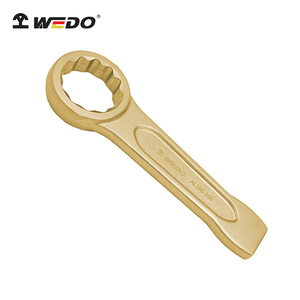


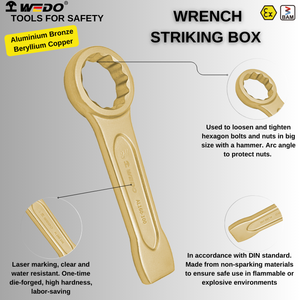


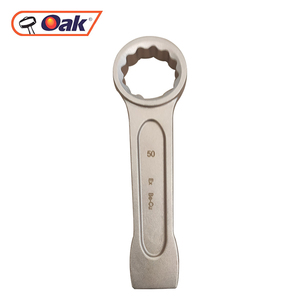









Non sparking box wrenches are made of special alloys. These wrenches are used in petrochemical, gas, mining, and other industries with high exposed ignition risks.
These wrenches are useful for tightening or loosening nuts and bolts in hazardous environments. This is due to their strength and resistance to producing sparks. Some common types include:
Copper-Aluminium Alloy Box Wrench
A copper-aluminium alloy box wrench features a great strength-to-weight ratio. It works well where lightweight tools are required. The copper content guarantees anti-sparking properties, while the aluminium provides corrosion resistance. This makes the wrench suitable for offshore and chemical facilities.
Copper-Zinc Box Wrench
C36000 is a copper-zinc alloy traditionally used for non-sparking tools. The combination produces a bronze-like material that balances hardness and corrosion resistance. A copper-zinc box wrench is less prone to wear than other copper alloys due to this strength. Thus, it is ideal for use in tough working conditions.
Brass Box Wrench
A brass box wrench is made from copper and zinc alloys. They are malleable and corrosion-resistant. While not as strong as other copper alloys, their resistance to saltwater makes them suitable for marine applications. This also includes work with valuable equipment where anti-corrosion properties are important.
Copper-Nickel Box Wrench
This alloy provides exceptional resistance to corrosion in harsh environments. It maintains its integrity where other alloys may degrade over time. The addition of nickel increases the tool’s hardness and strength. This makes it effective in tasks that require heavy torque. A copper nickel wrench is often used in shipbuilding and underwater maintenance.
Insulated Box Wrench
An insulated box wrench protects the user from electrical currents. It is valuable in industries wiring power lines where workers might be near live circuits. These wrenches are crafted from materials like rubber-coated chrome vanadium steel. This ensures minimal electrical conduction while retaining the durability and leverage properties of steel.
Non-sparking tools have a variety of features that make them safe and useful. They include the following:
Sparking Resistance
As the name suggests, the main function of non-sparking tools is to reduce the risk of ignition in risky settings. These include chemical facilities, oil and gas industries, and mining. The materials used to produce these wrenches do not produce sparks when striking another metal. This lowers the risk of explosions in areas with flammable gases or liquids.
Durable Materials
Non-sparking wrenches feature sturdy materials like copper-aluminium, copper-zinc, or brass alloys. This ensures they do not wear out and continually provide a safe working environment. In addition, these materials resist corrosion in hazardous settings. This keeps the tools viable for long periods even with chemical exposure.
Box-End Design
Box wrenches have a closed-end design that fits over bolt or nut heads. This permits even torque application from multiple angles. It helps avoid rounding and damaging workspace fasteners. The box-end's shape and non-sparking materials also help ensure safety and efficiency.
Torque Power
These wrenches can deliver high torque without slipping or stripping fastener heads. The alloy's strength allows it to handle heavy loads without bending or breaking. This makes non-sparking wrenches invaluable for tough industrial tasks.
Lightweight Construction
Many non-sparking wrenches combine copper and aluminium, producing tools with lightweight properties and high strength. This makes handling easier and reduces user fatigue. It is especially useful in industries like offshore drilling, where workers need to operate safely for long periods.
Non-sparking tools have a large commercial value across different markets for the following reasons:
Sparking Risk Reduction
The main value of non-sparking tools is their ability to shrink the risk of ignitions and explosions in hazardous spaces. These include chemical plants, oil and gas refining, and mining operations. The demand for safe working conditions in these industries makes the tools essential for reducing accidents and property damage. This ensures them a critical role in people' operations.
Industry-Certain Demand
Non-sparking wrenches are highly sought after to ensure safety in the chemical, petrochemical, marine, and other hazardous environments. The constant demand in these industries makes them a special tool category with specific use cases. This also guarantees a steady flow of customers.
Material Science Advancements
There are always advancements in the material science used to produce non-sparking tools. New alloys like copper-aluminium provide a great strength-to-weight ratio. They improve the tools' durability and performance. These improvements enhance tool safety, corrosion resistance, and effectiveness.
Increased Tool Performance
Many non-sparking wrenches are designed with extra features. These include ergonomic handles, lightweight construction, and greater torque power. All of these make them easier and more efficient to use. This increases their appeal to multiple industries and users alike.
Expansion of Applications
These industry demands are driving the expansion of non-sparking box wrench applications beyond traditional users. Working with electrical equipment is one space where value is realized due to their anti-sparking properties and insulated design. The tools are becoming valuable in construction, shipbuilding, and maintenance. That is why they are useful in more commercial situations than before.
When selecting wrenches, buyers need to consider the following factors:
Safety Requirements
If their clients work in environments with combustible gases, chemicals, or explosives, wrenches with the highest anti-sparking properties are most likely the best choice. This will help avoid accidents in high-risk spaces.
Corrosion Resistance
Clients who work in marine or chemical industries should be given wrenches that resist corrosion. Options with brass or copper-nickel alloys offer great resistance in such areas. It ensures the tools remain functional for as long as possible.
Durability and Strength
Buyers should focus on material composition to determine durability. Copper and aluminium alloys provide a good strength-to-weight ratio. On the other hand, copper-nickel alloys offer increased strength and wear resistance. These will ensure the tools withstand heavy use.
Size and Range
Clients will most likely prefer versatile wrenches that come in various sizes. Those with adjustable features can accommodate different fastener sizes. This will provide flexibility for multiple applications.
Ergonomic Design
Buyers must pay attention to comfort. Wrenches with long handles provide better torque. Those with anti-slip grips offer greater control and safety. Both enhance the users' experience and efficiency.
Compliance with Industry Standards
Buyers should ensure the selected wrenches meet necessary industry safety and performance standards. This includes certifications from reputable organisations. It ensures that the tools perform as expected without compromising safety.
Yes, marine industries have a great use for wrenches that resist corrosion and employ non-sparking materials. These include brass, bronze, and copper-nickel alloys. Workers in this space face exposure to saltwater, chemicals, and humid conditions. That is why they need tools made from materials that do not rust or corrode.
Sorry, there are no alternatives that will perform as well as non-sparking wrenches in hazardous marine environments. Buyers whose clients operate in this space are advised to procure non-sparking tools as the most effective means of ensuring longevity, safety, and reliability.
Besides the chemical and marine industries, other spaces such as mining, pharmaceuticals, and even fireworks manufacture also use these wrenches. Mining companies use them to avoid sparks in tunnels. Pharmaceutical facilities use them because they need clean, corrosion-resistant tools to work with chemicals and drugs. Fireworks manufacturers use them because any spark could cause an explosion. That is why they are essential in any space with flammable materials or explosive atmospheres.